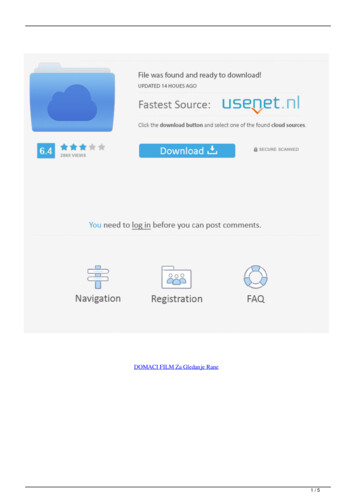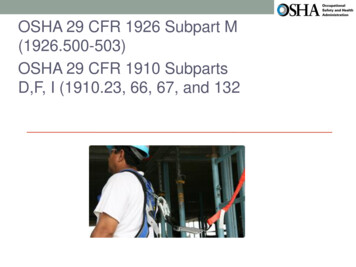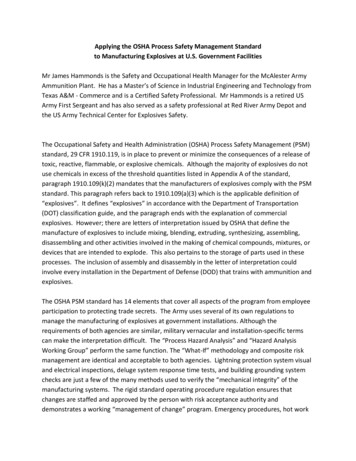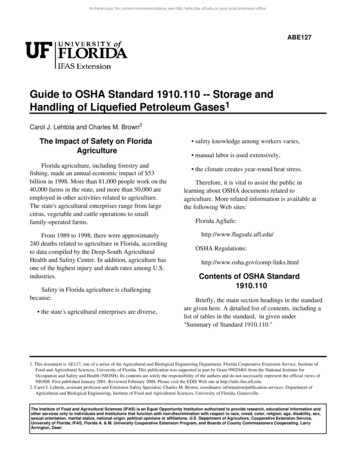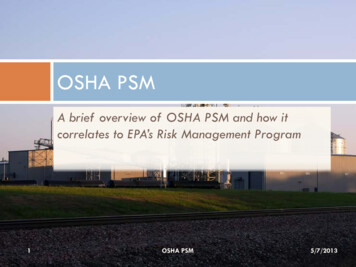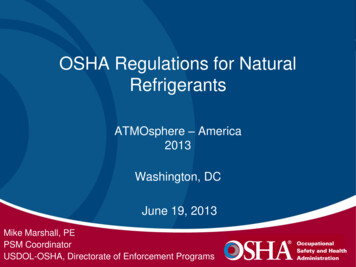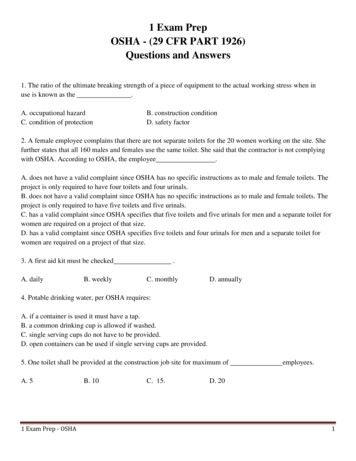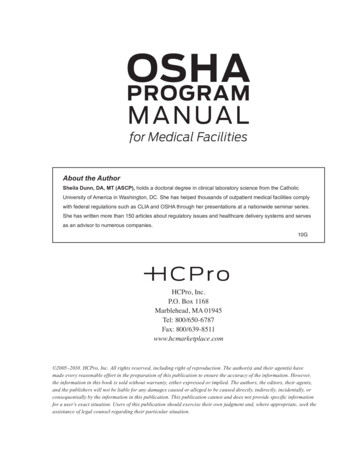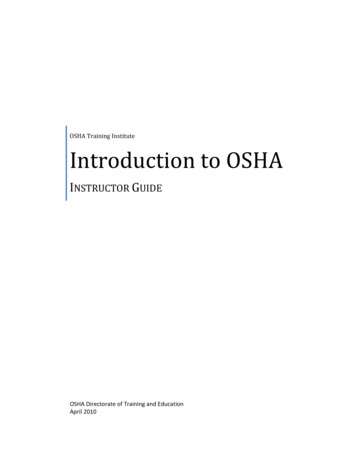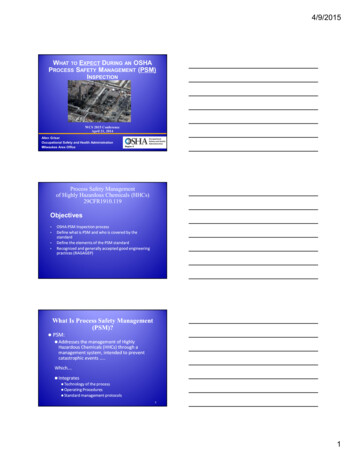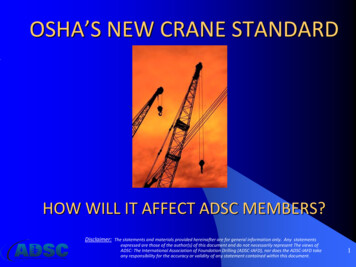
Transcription
OSHA’S NEW CRANE STANDARDHOW WILL IT AFFECT ADSC MEMBERS?Disclaimer: The statements and materials provided hereinafter are for general information only. Any statementsexpressed are those of the author(s) of this document and do not necessarily represent The views ofADSC: The International Association of Foundation Drilling (ADSC-IAFD), nor does the ADSC-IAFD takeany responsibility for the accuracy or validity of any statement contained within this document.1
IntroductionMobile cranes are usually one of the mostimportant, productive, and expensive pieces ofequipment used on deep foundationinstallation projects.Crane operations typically bear the greatestpotential for disaster, perhaps more than anyother activity on a construction project.2
IntroductionPlease note that this presentation is one ofmany possible interpretations of the new OSHAcrane standards. In addition, it only addresseschanges made to the federal OSHA standardsand may not address any individual state OSHAplan requirements, which may differ. Pleaseconsult your state and local requirements aswell as the federal requirements before youmake changes to your business operations.3
OverviewCrane accidents are often the mostcostly of construction accidentswhen measured either in dollars orworse . LIVES !This is a primary reason whyOSHA has set into place a new setof safety standards regarding theuse of cranes in the United States.4
Crane-Related Deaths in ConstructionFrom 1992-2006 632 crane-related construction worker deaths,from 611 crane incidents 17 multiple deaths incidents resulting in 38deathsSource: U.S. Bureau of Labor Statistics Census of Fatal Occupational Injuries Researched by theCPWR (The Center for Construction Research and Training)5
Crane-Related Deaths in Construction1992-2006Cause of DeathNumber of DeathsPercentageOverhead power lineelectrocutionsStruck by crane loads15725%13221%Struck by crane or crane parts12520%Crane collapses8914%Falls569%Caught in/between305%Other causes437%632100% (rounded)Total6
History Of Crane Standards In The US 1916 – ASME Code of Safety Standards for Cranes(American Society of Mechanical Engineers) Between WW I & WWII - US Army & Navy created MilitaryCrane Safety Standards 1943 – ANSI B 30.2 Safety Codes for Cranes, Derricks, and Hoists(American National Standards Institute) 1968 - PCSA Standard #2 Mobile Power Crane and Excavator &Hydraulic Crane Standards (Power Crane and Shovel Association) 1968 - ANSI B30.5, Safety Code for Crawler, Locomotive andTruck Cranes7
History Of Crane Standards In The US“Be it enacted by the Senate and House ofRepresentatives of the United States of Americain Congress assembled, that this Act may becited as the Occupational Safety and Health Actof 1970.” Public Law 91-596 - December 29,1970This Act shall take effect one hundred andtwenty days after the date of itsenactment.(April 28, 1971)8
History Of Crane Standards In The USOSHA’s federal crane and derrick standard for construction hasbeen virtually unchanged since 1971.In late 1998 the 15 member Advisory Committee on ConstructionSafety & Health (ACCSH) formed a “Crane Work Group”.In late 2000, the Crane Work Group recommends to ACCSH forOSHA to form a Negotiated Rulemaking Committee.In a July 2002 notice of intent to create a negotiated rulemakingcommittee, OSHA acknowledged that industry consensusstandards had been updated and crane technology hadchanged considerably over three decades.9
History Of Crane Standards In The USOn June 12, 2003, OSHA announced its decision to establish aCrane and Derrick Negotiated Rulemaking Advisory Committee(C-DAC) under the Negotiated Rulemaking Act (NRA), theOccupational Safety and Health Act (OSH Act) and the FederalAdvisory Committee Act (FACA).The Committee would be composed of no more than 25 membersincluding OSHA representatives and a facilitator with anappropriate balance of interests for negotiated rulemaking.Between July 30, 2003 – July 9, 2004, OSHA held eleven C-DACmeetings.At 3:15 p.m. EDT on July 9th 2004, C-DAC reached final consensuson all issues.10
ADSC Participation in Rulemaking1998 – 2000Member of the “Crane Work Group”2003-2004Provided testimony to C-DAC to prevent Drill Rigs from inclusionin the definition of a crane, ground conditions, allowboatswain’s chair usage, and power unit mounting on rear ofcrane.2009Provided testimony to OSHA at Public Hearings, endorsing thenew proposed rule, as written, including mandatory drugtesting similar to DOT testing.
Why Is A New Standard Needed? OSHA 1910.180 and 1926.550 are 39 years old There have been only minor revisions since original publication There were some oversights in the original There have been many technological advances for craneequipment in the last four decades The new standard gets away from SHOULD and includes moreSHALL statements Focusing on competent persons and giving more defineddescriptions of personnel’s responsibilities Use of multiple ANSI/ASME standards and creating their own(some are more stringent)12
Where Is The Proposed Rule?http://www.osha.gov/doc/proposedrule/Cranes Derricks Proposed Rule.htmlThis is the 1100 page document describing OSHA’s rationale foreach section of the proposed rule. The actual standard is thelast 100 pages.13
Comparison Of Standards OSHA 1910.180 – 17 pages OSHA 1926.550 – 15 pages ASME B30.5 – New Subpart N – 119 pages46 pages14
Comparison Of StandardsOperator Qualifications1910.180 – nothing1926.550 – nothing1926.1400 – 8 pages15
Comparison Of StandardsFloating Cranes1910.180 – nothing1926.550 – 1 page1926.1400 – 9 pages16
Comparison Of StandardsCrane Signaling1910.180 – nothing1926.550 – nothing1926.1400 – 3 pagesUse of standard signals ismandatory (specialconditions apply)Signalers must be qualified17
Comparison Of StandardsWire Rope1910.180 – nothing1926.550 – nothing1926.1400 – 3 pages18
Comparison Of StandardsGround Conditions1910.180 – nothing1926.550 – nothing1926.1400 – 1 page19
Comparison Of StandardsAssembly & Disassembly1910.180 – nothing1926.550 – nothing1926.1400 – 6 pages20
Comparison Of StandardsPower Lines1910.180 – nothing1926.550 – ¼ page1926.1400 – 11 pages21
Comparison Of StandardsInspections1910.180 – 4 pages1926.550 – nothing1926.1400 – 11 pages22
Comparison Of StandardsPersonnel Platforms & Boatswain’s Chair1910.180 – nothing1926.550 – 8 pages1926.1400 – 12 pages23
What’s New?Inspection Criteria Fall Protection Signal Person Qualification Power Line Safety Ground Conditions Authority To Stop Operations Operational Aids Operator Certifications 24
What Cranes Are Included?Types Of Cranes We Use: Crawler Mount Lattice BoomCarrier Mount Lattice BoomCrawler Mount Telescopic BoomCarrier Mount Telescopic BoomRough Terrain Telescopic Boom25
Lattice Boom Crawler26
Carrier Mount Lattice Boom27
Crawler Mount Telescopic Boom28
Carrier Mount Telescopic Boom29
Rough Terrain Telescopic Boom30
Other Types Of CranesPedestal Mount and Conventional Tower Cranes31
Other Types Of CranesCranes On Rails32
Other Types Of CranesCarry-deck CranesLocomotive Cranes33
Other Types Of CranesCranes On BargesFloating Cranes34
Other Types Of CranesDerricks35
Other Types Of CranesPedestal CraneSide Boom Tractor36
Is This A Crane?YES!The new standard definesthis type of dedicated or selfcontained hydraulic piledriver as a crane.This is primarily because ofits limited lifting capabilities,which are regulated by theirload charts.37
Is This A Crane?YES!This is a Crane with adrill attachmentsuspended from, andattached to, the crane.38
What Is Not Defined As A Crane ForkliftsTrack LoadersExcavators (Track Hoe/Backhoe)Concrete Pump Trucks w/boomPower ShovelsDigger DerricksTow TrucksVehicle Mounted Work PlatformsSelf-propelled Elevating Work PlatformsStacker CranesMechanic’s Trucks With Hoisting DevicesCome-A-Longs and Chain FallsGin Poles For Communication Tower WorkTree Trimming and tree removal workAnchor handling with a vessel or barge using an affixed A-frameRoustabouts39
Is This A Crane?NO!This is a dedicated or selfcontained drill rig or in OSHAspeak – “Dedicated Drilling Rig”used for the installation ofdrilled shafts, drilled piers orcaissons.While it may have some verylimited lifting capacities, it isNOT a crane.See exclusion #11 under section1400 - Scope40
What Do We Do With Our Cranes?Load and Unload Materials & Equipment Drive & Extract Piling Drill CFA Piling Drill Shafts (Caissons) Set & Extract Casing Set Reinforcing Cages Pour Concrete (Bucket or Tremie Pipe) Others? 41
Cranes Used to Drill Shafts & Piles42
Cranes Used To Drive Casing & Piling43
Cranes Used to Set Rebar Cages44
New Definitions for Employees A/D SupervisorAppointed PersonCompetent PersonDedicated SpotterOperatorQualified EvaluatorQualified PersonQualified Rigger45
Ground Conditions (Before)Most often, the deepfoundation contractor is oneof the first to arrive to ajobsite. Typically, the siteneeds some “improvement”.If underground utilities, vaults,poor soil conditions are notidentified before we get onsite, ordealt with once we arrive, badthings can happen to cranes.46
Ground Conditions (Now)The controlling entity shall:Ensure that ground preparationsnecessary to meet the requirementsin paragraph (b) of this section areprovided.(b) The equipment shall not be assembled or used unless groundconditions are firm, drained (except for marshes / wetlands), and gradedto a sufficient extent so that, in conjunction (if necessary) with the use ofsupporting materials, the equipment manufacturer’s specifications foradequate support and degree of level of the equipment are met.Locate all hazards that are identified in all available documents and inform47the crane user of them.
Ground Conditions (Now)Controlling Entity:A prime contractor, general contractor, constructionmanager or any other legal entity which has theoverall responsibility for the construction of theproject - its planning, quality and completion.48
Crane Assembly / Disassembly Lengthy Procedures For Crane Assembly/DisassemblyRequirements For Supervision Knowledge and AuthorityCrew Training And InstructionsNo Person Under The Boom During Pin RemovalProper Outrigger Blocking Is Mandatory49
Crane Assembly / DisassemblyNo part of crane, line or load may beable to reach within 20 feet of apower line during setup.Exceptions: de-energized andgrounded power lines – or - useof a dedicated spotter – or proximity alarms.Assembly/disassembly below powerlines is prohibited, unless line isde-energized and grounded.50
Power Lines In Crane Operations You must identify work zone and either mark boundaries, userange limiting devices or range control warnings You must determine if any part of crane, line or load could getwithin: 20 feet of a power line 350kV or less 50 foot for all lines over 350kV If yes, you must either: De-energize and ground Maintain 20 or 50 footclearance Use Table A and conducta planning meeting with crew51
Power Line Minimum ClearancesTable AVoltage (kV)Up to 50Minimum Clearance Distance(feet)1050 to 20015200 to 35020350 to 50025500 to 75035750 to 100045Over 1000As established by the lineowner52
Power Lines In Crane OperationsSome special requirements for working below power linesinclude training of operators and crew on:–Procedures to follow after power line contact–Danger of a potential energized zone–Operator’s emergency procedures–Safest means to evacuate equipment–Need for crew to avoid approach–Safe clearance from power lines53
Power Lines In Crane Operations All power lines are presumed to be energized unless confirmedto be de-energized by the utility owner/operator AND visiblygrounded at the worksite. All power lines presumed to be un-insulated. Shall understand limitations of insulating links, proximity alarmsand range control devices, if used. Dedicated spotters shall be trained. There must be at least one electrocution hazard warning stickerconspicuously placed in the cab of the crane.54
Crane InspectionsAfter Modification After Repair Or Adjustment Post Assembly Each Shift Monthly Annual Comprehensive 55
Crane Inspections Monthly Inspections– Documented– Kept on file for three months Annual Inspection––––DocumentedDetail inspection criteriaFunctional testingKept on file for 12 months or next annual inspection56
Crane Inspections Severe Service– Shock load, corrosive atmosphere, etc.– Inspect exposed items/conditions– Document Not In Regular Use– Idle more than three months– Monthly inspection must be performed– Document57
Wire Rope InspectionShift Inspection Monthly Inspection Annual Inspection 58
Safety DevicesMandatory Equipment––––––Crane level indicatorBoom stops (except hydraulic booms)Jib stopsLocks for foot pedal brakesIntegral check valves for hydraulic outriggersRail clamps and stops for equipment on rails59
Operational AidsRequired equipment – must be in service exceptwhere specified temporary alternativemeasures are met:– Boom hoist limiting device– Luffing jib limiting device– Anti two-block device (cranes manufactured after2/28/92) Exception: lattice booms used fordragline, clam shell, scrap magnet, drop ball,marine operations and pile driving work60
Operational AidsBoom angle or radius indicator Jib angle indicator (luffing jibs) Boom length indicator (telescopic booms) Load weighing devices (load momentindicators, rated capacity indicators or ratedcapacity limiters – cranes manufactured after3/29/03 Outrigger position indicators (cranesmanufactured after 1/1/08) Hoist drum rotation indicator (if drum is notvisible to operator) 61
Fall ProtectionFall protection above six feet, with exceptions:– While at a work station or going to and from a workstation– When walking point to point along a horizontallattice boom that has been lowered to the groundand supported62
Fall ProtectionFall protection is required above 6 feet duringnon-assembly/ disassembly work,w/exceptions: Employee is at or near the draw-works (when theequipment is running) In the cab On the deck63
Fall ProtectionFall protection must be used when working over15 feet during the assembly/disassembly process,except when the employee is: At or near the draw-works In the cab, or On the deck64
Fall ProtectionAnchorages may be any substantial part of the boom orto any substantial piece on the equipment (using correctfall protection equipment).A fall arrest system is permitted to be anchored to thecrane/derrick’s hook or other part of the load line wherethe following requirements are met: A qualified person has determined the set-up and ratedcapacity meets or exceeds the anchorage requirements The operator is aware it is being used for this purpose65
Operator Certification / Qualification No physical examinations or mandatory drugtesting requirements Re-certification / qualification must becompleted every five years Four acceptable methods of certifyingemployees66
Operator Certification / QualificationOption (1) – certification by an accredited craneoperator testing organization– Accredited by a nationally recognized accreditingagency– Certification is portable– Valid for five years– Program must be reviewed by a nationallyrecognized accrediting agency every three years67
Operator Certification / QualificationOption (2) – qualification by an audited employerprogram– Developed or approved by an auditor certified byan accredited crane operator testing organization– Auditor is not an employee of the employer– Tests should be administered per nationallyrecognized test administration standards– Program shall be audited within the first threemonths, then once every three years– Qualification is not portable and valid for five years68
Operator Certification / QualificationOption (3) – qualification by the US military– Qualification is not portable– Valid for the period of time stipulated by the issuingentity69
Operator Certification / QualificationOption (4) – licensing by a government entity– Must meet or exceed requirements of this subpart– Valid only within the jurisdiction of the governmententity– Valid for time specified by the government entity,but no longer than five years70
Operator Certification / QualificationCertification / Qualification Criteria:Written Testing on:–––––Controls and operational performanceAbility to calculate the load/capacityProcedures for power line contactSite preparationAbility to read manuals/charts relevant to theequipment being operated71
Operator Certification / QualificationCertification / Qualification Criteria: Pass practical examination Ability to perform a pre-shiftinspection Operational and maneuveringskills Application of load chartinformation Application of safe shut downand securing procedures72
Operator Certification / QualificationEmployer must revoke operatorscertification if they have reasonto believe the employee is notqualified to operate. All programs shall have provisionsfor retraining employees. The current training records mustbe on file during the operator’semployment. 73
Operator Certification / QualificationMany States, and/or Cities now require operatorsof essentially all cranes to provide proof of licensein addition to certification upon request by aninvestigator.An employer may be cited by the governing entityfor a violation of the requirements, as well asthe revoking of the license from the operator.74
Operator TrainingExamples Of Training Topics: Identification Of Crane TypesCrane Definitions: Rated Strength, Ultimate Strength, Etc.Component IdentificationCrane ApplicationOperating ProceduresQuadrants Of Operation & Their Adverse Effects: "Over Side", "Over Rear" Or “360 ”Preparing For A LiftDescribe How To Pre-plan A Crane LiftANSI Signal ChartThe Principles Of Leverage And StabilityThe Concepts Of Structural Competence Or Strength Of MaterialsUnderstanding Load ChartsWire Rope - Construction, Types, InspectionHow To Change Boom Sections (Lattice Boom Cranes)Pick And Carry OperationsPerform Crane InspectionsBe Able To Answer Questions Pertaining To The Crane Or Its AttachmentsKnow What Required Maintenance Must Be Performed75
Operator Certification / QualificationThere will be a four year phase–in process for theemployer to get their operators to obtaincertification.New operator training will be allowed under thecontinuous supervision of a certified operatorwith some minor exceptions.76
Authority to Stop OperationsWhenever there is a concern for safety, the craneoperator shall have the authority to stop andrefuse to handle loads until a qualified personhas determined that safety has been assured.77
Signal-Person QualificationTraining Requirements– Know and understand signals to be used, as well as all formsof signals (i.e., voice, hand, radio, etc.)– Be competent in the application of the type of signals to beused– Have basic understanding of crane operation andlimitations, including the crane dynamics involved inswinging and stopping loads and boom deflection fromhoisting loads– Must be able to effectively communicate to crane operator(i.e., English-English, Spanish-Spanish, etc.)A qualified evaluator must conduct the training78
Wire Rope InspectionCompetent person to conduct visualinspections before each shift, monthly andannually Categorize deficiencies in: – Category I– Category II– Category III79
Wire Rope InspectionShift Inspection – Before each shiftMonthly Inspection – All wire ropes, includingrunning ropes (Documented)Annual Inspection – At least every 12 months,unless not feasible due to set-up. Moredetailed, including wire rope that is normallyhidden during daily/monthly inspections, etc.(Documented)80
Wire Rope – Category I
Apr 28, 1971 · committee, OSHA acknowledged that industry consensus . in the definition of a crane, ground conditions, allow boatswain’s chair usage, and power unit mounting on rear of . There must be at least one electrocution hazard warning
